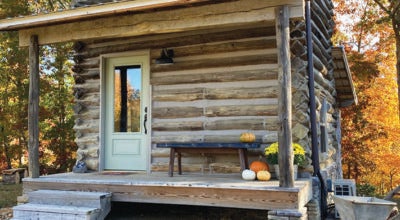The Literary Corner: Renegade Writer’s Guild
Published 9:11 am Thursday, March 25, 2021
|
Getting your Trinity Audio player ready...
|
Copperheads
By Gaye Hoots
When I was a small child, my grandfather would often catch blacksnakes, so I had no great fear of snakes. He may have relocated them to the barn or corncrib where rodents were a problem, but he never harmed one unless he caught them in his chicken house. We lived with my grandparents until I was almost 6 years old, but I never saw a copperhead snake there.
Before my sixth birthday, we moved to Marchmont, a large plantation-style house built on top of two tiers or banks with a base of rocks. Copperheads hibernate in rocky areas, and the overgrown boxwood gardens attracted them. They were a familiar sight, and one we respected. I watched my father kill a large copperhead with a hoe shortly after we moved there.
Early fall brought piles of leaves for the snakes to hide in, where their colors of gray and brown made them almost invisible. Daddy was working away from the house most of the day, and mother was terrified of snakes, so I considered myself the family protector. The first copperhead I encountered while alone was five to six feet long. He quickly coiled into a tight ball when he saw me. I went to get a hoe as I had seen Daddy do while the snake remained coiled. I struck a lick with the hoe aiming for just behind the head as I had observed the men doing. I managed to maul him to death and proudly stretched out my trophy in the driveway.
Daddy found him there and gave me another lesson in snake killing. He explained that when the snake was longer than the hoe handle, the snake could strike me. He emphasized this by stretching the snake out beside the hoe handle so I could see his point. I killed numerous copperheads while we lived there but did not bother other snakes unless they were on the porch where we might step on them.
One story Faye tells is that she had to walk to the bus without me, and Daddy told her to look for snakes in the road. She decided it would be easier to spot the snakes in the drive if she walked in the side ditch. It was littered with leaves, and she almost stepped on one of the snakes. Daddy heard her yell and killed the snake.
Once Mother was working in the garden alone, and a copperhead was coiled there. She had a hoe but was still afraid of the snake. Finally, she forced herself to kill it because she said if it escaped and one of us was bitten later, she would always believe it was that snake.
One of our neighbors, a Mr. Slater, was bitten by one, but the snake died, and he didn’t get sick. Gene O’Mara, who also worked on the farm, was not so lucky. He was bitten and was seriously ill for three months.
Years later, when I lived in the log cabin on Odell Myers Road, I found two baby copperheads and killed them. My grandkids were preschool age, and the snakes were on my porch. I called an exterminator because I feared there was a nest of snakes. He crawled around the perimeter of the crawl space beneath the cabin and found a couple of snake skins but no snakes. That was about 30 years ago, and that was the last one I encountered.
An Irish Blessing
By Julie Terry Cartner
“Haven’t you noticed? Even the birds won’t go in there.” It was a glorious day, blue skies, white, puffy clouds, and the small hint of green promising spring would soon come. Birds dotted the yard, not only the cardinals and blue jays of winter, but also robins hopped on slender legs, hunting and pecking, claiming their spots of turf. In the breeze we could hear the various chirps of songbirds. Blackbirds, almost in military formation, swooped and swirled through the breeze. Spring was certainly around the corner.
But in one area of the woods, black branches grasped at an unreachable sky. No birds adorned the branches, no peepers called out their cheery greetings, and gray clouds overwhelmed the white. Brilliant daffodils rimmed what once appeared to be the foundation of a house, but not even the crackled red of a chimney remained. Did that oak once grace the front yard of that house? Did some housewife plant the bulbs that flowered even today? Did a father hang a swing from the gnarled branches of that maple tree? Who were they and where did they go? What happened? Tragedy seemed to color the very air surrounding the former homestead.
“I did notice and wondered why,” I replied. “Is there a story, and who are you?” I looked inquisitively toward the elderly woman standing beside me. “I’m Maureen, and I’m trying to decide whether or not to buy this property. I’ve always loved it, and it seems like it would be a wonderful place to raise my two energetic little boys. I’ve driven by it many times, and this time I noticed the For Sale signs. “Do you know why it’s for sale now?” I had no idea where the woman had come from. I was alone one minute and not the next.
“Yes, there’s a story. There’s always a story. I’m Bridget,” she added with a smile. “My mother and father married and built their home on this land, right over there,” she pointed. “It was 1915, and they moved in as newlyweds. I was told they were so happy. A year later they had my brother, then another brother, and, in 1918, I was born. Being country folk and isolated from others, they thought they would be safe from the Spanish flu, but that was not the case. Ma was weak from giving birth and got sick first. Then Nate and Michael succumbed. Pa was so devastated by grief that he took me and left. He saddled his horse, put me in a papoose, and we went west, deep into the mountains. The house and gardens went silent.
“The only thing he took with him was a plaque. Ma’s parents brought it with them from Ireland, then gave it to her when she and Pa built their house. It always held the place of honor over the mantle. Wherever we went, he took it with us. He told me he couldn’t bear to give up this last piece of his beloved wife. But when he was dying, he asked me to bring it back here, to their home.” Pulling the plaque out of her bag, Bridget asked, “Are you going to buy this piece of woodland?”
Almost surprising myself, I said, “Yes, I believe I am.” As soon as I said it, I knew it was true. This would be a good place to raise my boys.
Searching my face, she finally seemed to reach a conclusion. “When you build your house, will you put this over the mantle? And when you look at it, will you say a prayer for my family and me? I have no family to pass it on to, and it needs a home, this home.”
Agreeing, I took the gift from her gnarled hands and walked into woods where no birds would sing. As I stepped over what I imagined to be the threshold of the former house, a lone bird began to warble. I read the inscription as more birds began singing: “May you always have walls for winds, a roof for the rain, tea beside the fire, laughter to cheer you, those you love near you, and all your heart might desire.” Touched, I looked up to thank the elderly woman. She was gone.
Spanish-American War
By Marie Craig
The fifth history book I wrote about Davie County was Davie County in the Spanish-American War. This one was particularly difficult because of the following reasons. The Spanish-American War began in 1898. Descendants and photographs were difficult to find so many years later. It was such a short period of time. There are so many conflicting descriptions about what caused this war. Why was the United States involved? The three locations, Cuba, Puerto Rico, and the Philippines, were far apart and had differing strategies and goals. Each of these three had different dates for the official end of the war. Names are not uniform: War with Spain, Spanish War, Spanish American War, and Spanish-American War. Puerto Rico was spelled “Porto Rico” in the early 20th century. Military records were destroyed in a fire in St. Louis in 1973. [“On July 12, 1973, a disastrous fire at the National Personnel Records Center (NPRC) destroyed approximately 16-18 million Official Military Personnel Files (OMPF).” ]
This book has a summary of the Spanish-American War and the resulting Philippine Insurrection. There are biographies, photographs of men, photographs of tombstones, newspaper articles, and obituaries. Fifteen men from Davie County volunteered or were drafted for service during this war.
The 15 men were Thomas A. Allsabrook, Albert S. Arndt, Lewis Marvin Blalock, Harrison “Harry” James Cain, Perley Lafayette Carter, Cyrus Watson Lowery, Bernie Robert McLean, William G. Murchison, John Tillet Parnell, Lee Rights, Tandy Meronie Shermer, William Gaston Shermer, Oscar Burgwyn Smith, Marshall Boone Stonestreet, and Luther Leon West.
There were no fatalities in this group of fifteen. They had a reunion in 1938 according to an article in the Salisbury Sunday Post. I was able to learn interesting facts about each one. Allsabrook lived in Cooleemee and worked at the mill. Arndt was in the Army for 20 years, serving as horse shoer during World War Two. Blalock lived in Cooleemee after the war, divorced, moved to Oregon and changed his name. Cain changed his age to one year older so he could join. His father had him returned to the U.S. He lived in California for a time and came back to Davie for a visit. While here, he was killed in a sawmill accident.
Carter served in the Philippines, and I met his daughter who shared multiple photos. Lowery was the Cana mailman. I met his grandson who is kin to me because Lowery’s wife was my first cousin, twice removed. McLean lived in Cooleemee and worked at the mill. Col. Murchison also served in World War I and is buried at Arlington. Parnell was a blacksmith in Mocksville and lived on South Main Street. Rights worked in Winston-Salem; one of his jobs was paving the streets with Durax. Tandy Shermer farmed in Advance. He was the first Scout Master of the First Boy Scout troop in Davie County. Will Shermer served in the Philippines, and I found a photograph of him with other servicemen in front of a grass hut. Smith moved to Salisbury and constructed railroads and was later a conductor. Stonestreet was a rural mail carrier and later a director of the Mocksville Savings and Loan. He lived to be 102. West was a farmer in Farmington township.
These were 25 men who served their country and later resumed their civilian lives in or near Davie County. This book is available at www.lulu.com.





